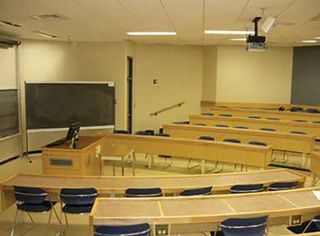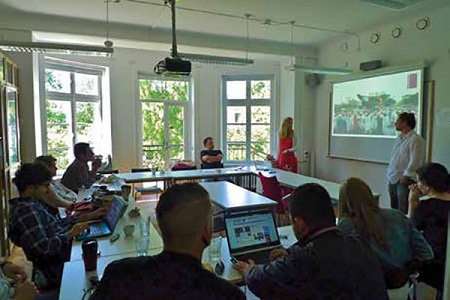Electronic audio capture is becoming more important in the classroom. With VoIP (Voice over Internet Protocol), trends in BYOD, and video production in education, there is an influx of “audio novices” setting up learning space systems. While this expansion is certainly good for users, it is a difficult situation for those not expertly aware of the challenges and nuances of audio capture.
The basic goal of audio is to get the microphone as close to the source as possible. This sounds like a simple task, but in reality is the most difficult aspect of electronically reproducing a sound. So many variables come into play. The producer has to decide how much of the mic can be shown in the picture, if any at all. When multiple mics are used, echo, and pick up patterns must be addressed. There are room acoustics to account for. This means that each application is a “one-off”. There is no “one-size-fits-all” mic solution.
Projectors are a common feature in today’s learning spaces. We cannot let audio become an afterthought. Quite often in education facilities, the person setting up the system may not have sufficient experience in audio. The single largest challenge today is educating the audio novice in order for them to better understand what solutions are available and how to implement them. The old adage holds true here: people will accept less than perfect video. But if they can’t hear and understand the audio track, they will shut off the program. Learning objectives will not be met.
This is a basic “how to” tutorial for the novice audio engineer.
The Classroom
Though we are discussing audio in this article, it is impossible to address electronic communications without mentioning video. The days of audio only communications is quickly disappearing. However, audio is in my mind still the more important of the two, and will always be. If you can’t understand what the presenter or program is saying, the communication is useless.
VoIP is the accepted term for audio and video over the Internet, and tends to be used for collaborative communications. A one-way program is referred to as IPTV. I think a better term for both as a whole might be IPVAC (Internet Protocol Video Audio Communications). But for the sake of clarity, I will use the accepted industry terms.
Within that term, are two sub categories, one-way and collaborative. As we use these in the classroom, we need to understand how audio will be integrated. Video is relatively easy to set up, al you need to do is place a camera. Audio is much harder.
This article will address the audio for VoIP and IPTV, as well as recorded programing. The three uses that will affect audio, and video solutions for the classroom are IPTV, Collaborative, and the use of recorded video as homework assignments using mobile devices.
With Common Core being implemented nationwide, and the move to create the “Connected Classroom,” understanding how to set up a connected classroom is essential. Adding IPVAC to the education experience will create endless possibilities.
IPTV One-Way Communication
With the right resources and training, anyone can create their own IPTV channel. It’s a great learning tool for the students; not only do they learn how to produce a TV show, they learn about Internet marketing and how to drive traffic to a web site. This technology could be used for something as mundane and dated as the “Sage On The Stage,” or something more engaging. The programming is limited in content only by the creativity of the programmer. A classroom can set up their own IPTV studio in any corner of the room. The challenge here is that the space used may not be set up as a broadcast studio, with proper sound-proofing and effective echo management. The problems faced are the same as any broadcast studio faces. The challenge comes in when you are using a space as temporary location, managed by a novice audio engineer.

This university classroom has projection and power outlets, but what about audio? IPTV is great for teaching a media class how to create a broadcast TV program. The audio solutions here are established audio devices such as, shotgun mics, lavalieres, and handheld. I don’t see anything new here in terms of devices. The twist here is getting a forth grade teacher to understand enough about audio to properly mic a room. The most effective solution is a wireless lab mic for all of the speakers, and a mixer. The MXL FR-500WK is one example of this solution. Of course, this may exceed the school’s budget. If that is the case, boom mics may be the best solution.
Huddle Rooms & Collaborative Spaces
Smaller meeting rooms that utilize collaborative communications are now being referred to as “huddle rooms.” I just started hearing this term about a year ago; I believe it’s relatively new. This, in my mind, is the fastest growing trend in the history of communications. We can now have multiple people in multiple locations talking to each other, sharing documents, and seeing each other face to face. It will be a huge benefit for the classroom, as teachers and experts from all over the world can now collaborate and address a classroom; everyone in the conference can participate in the discussion.
We start with a mental picture of set up. Everyone in the room is facing the front, where a monitor hooked up to a computer is located. Everyone is watching the person on the monitor. The most simple solution for this application is a single boundary mic, hooked up through the USB port on the computer. Keep in mind that echo canceling is often included in software solutions such as Lync, Blue Jeans Network, GoToMeeting, and Google Hangout.
Once the number of people exceeds eight or 10, and the room expands out to over 25- by 25-feet, a multiple mic solution is required. This is where things get much more complicated (and expensive). It will be challenging to get mics in front of each student. A solution may be multiple boundary mics, or individual “stick mics.” MXL has a 4 mic mixer that can be used for up to four stick mics, or four boundary mics. Once you add multiple mics, each mic needs to have as narrow a pick up pattern as possible, to avoid the same voice being picked up by multiple mics. Mics with echo canceling may be required. The goal is for the students to be able to interact with the conference. This could also be achieved with a single mic that each student approaches when they have a question. It inhibits a free-flow discussion. However, given the large number of students in a classroom, this may be the exact solution that works the best. Ceiling mics can be used. However, they have their own challenges, and may be too expensive and complicated to set up.
There is no perfect solution, or “Magic Bullet.” Each room is different, as are the requirements. It is recommended that the novice to hire an audio expert to help design a system.
The Recorded Program & BYOD
BYOD video production is explosive in schools. Most every student has a smartphone (that records video) and computers for editing. It was once prohibitively expensive to require video assignment projects and video production in the classroom. With the proliferation of hand-held devices in each student’s hands, it is now possible for everyone to be a filmmaker. But these devices by nature are limited in their ability to record a quality audio track. There are many audio manufacturers filling this need. Many are new companies, and a few of the established brands are entering the field. Special products designed specifically for the hand-held devices are needed.
If one wants to be agnostic, and make their mic work through the 3.5mm analog jack, a TRRS plug is needed. All mobile devices have this jack for audio input. If the manufacturer wants to make it format specific, and plug in through the digital port, they need either USB or Lightening jack products. Up until now, Android USB ports were only used for data and power. It was announced that, next year, some manufacturers will be opening it up to audio input as well. This means that there may be more USB mics designed to work with portable devices in the future.
Mics for Apple products, utilize the Lightening port. However, the user can plug in the Camera Kit Connector, which is a Lightening port to USB adapter. With that, there are some mics that will work. At this time, the Camera Kit Connector will not work on the iPhone.
There are many manufacturers producing mics designed to work through the 3.5mm jack. Different kinds of mics for various applications include a hand-held interview mic, a wired lav mic, and shotgun mics.
As these new technologies make their way into the classroom, it is important for the tech deciders in the educational environment to stay on top of new products making their way into the market. These technologies are crucial for the education of the next generation. It’s important that we make the most of them by using the best hardware available. With myriad products available, and trends like huddle rooms, even the most experienced tech managers need to familiarize themselves with the new electronic landscape.
Perry Goldstein, CTS, is the Marshall Electronics/MXL director of sales & marketing.










